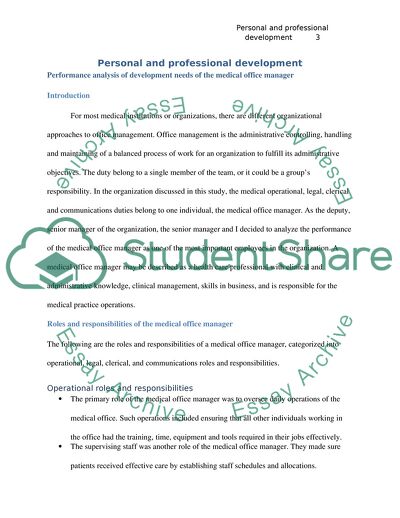
- Home
- Free Samples
- Premium Essays
- Editing Services
- Extra Tools
- Essay Writing Help
- About Us
- Studentshare
- Subjects
- Human Resources
- Personal and Professional Development
Personal and Professional Development - Coursework Example

- Subject: Human Resources
- Type: Coursework
- Level: Undergraduate
- Pages: 22 (5500 words)
- Downloads: 0
- Author: fdibbert
Extract of sample "Personal and Professional Development"
Office management is the administrative controlling, handling, and maintaining of a balanced process of work for an organization to fulfill its administrative objectives. The duty belongs to a single member of the team, or it could be a group’s responsibility. In the organization discussed in this study, the medical operational, legal, clerical, and communications duties belong to one individual, the medical office manager. A medical office manager may be described as a health care professional with clinical and administrative knowledge, clinical management, and business skills, and is responsible for medical practice operations. The primary role of the medical office manager was to oversee the daily operations of the medical office.
Such operations included ensuring that all other individuals working in the office had the training, time, equipment, and tools required for their jobs effectively. It was the responsibility of the medical office manager to assess staff performance and conduct office staff meetings regularly. Assessing staff performance regularly helps to deliver information regarding the running of the Royal Voluntary Service and to identify the needs of the staff. The medical office manager held meetings once in two weeks with the staff.
The medical office manager was expected to work with the finance department to approve pending invoices promptly and as well verify all timesheets for salaried employees and send them to Human Resources on time. It was the duty of a medical office manager to comply with all local, state, and federal law guidelines such as confidentiality, disaster communication, and providing staff with documentation and training concerning these guidelines. They kept up with these changing laws to make sure the practices managed were legally operating.
They as well make sure that the clinical staff adhered to the risk management policies. The medical office manager placed special emphasis on identifying circumstances that predispose patients and staff to harm and methods of controlling the risks.

- TERMS & CONDITIONS
- PRIVACY POLICY
- COOKIES POLICY